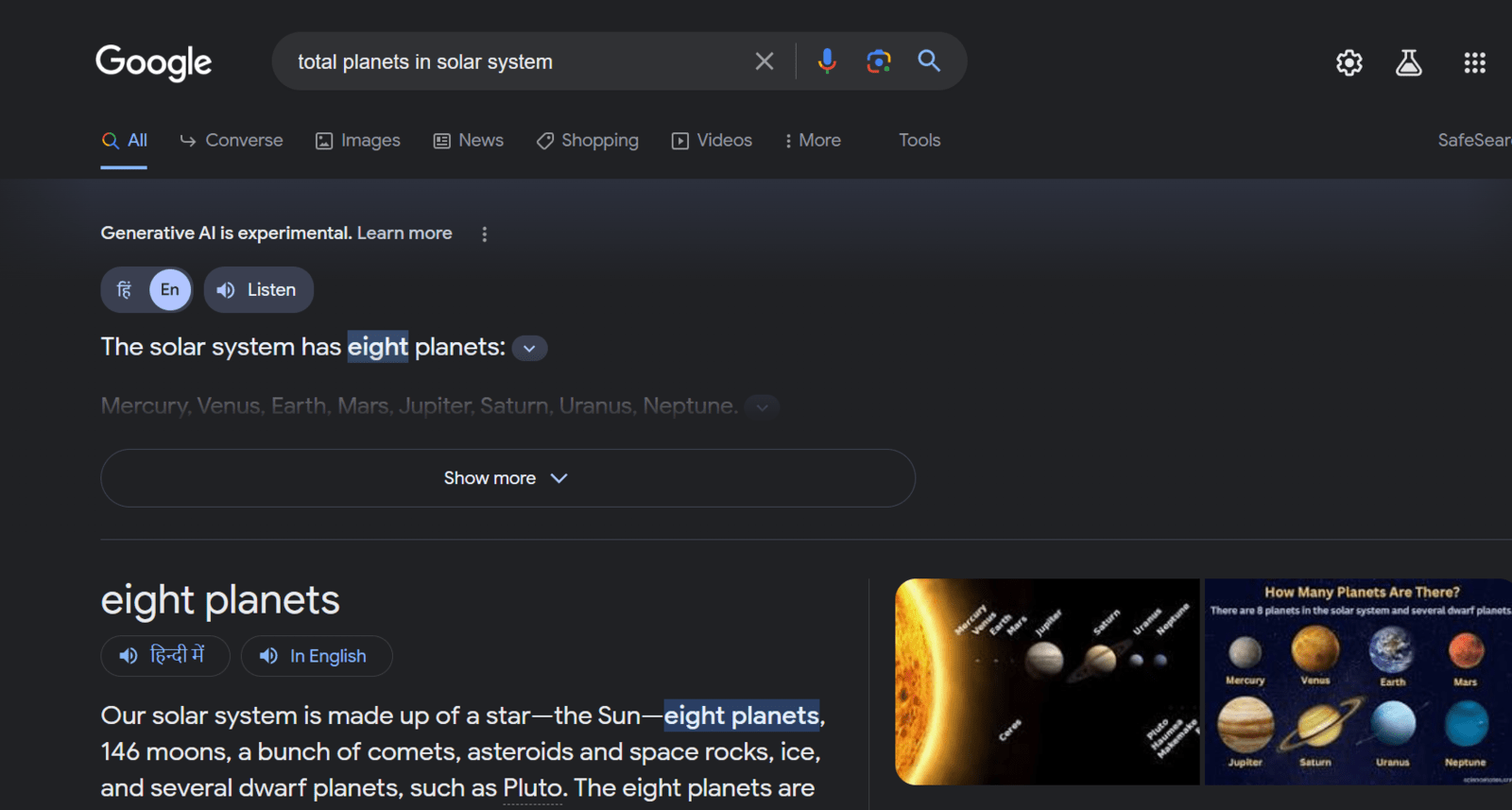Remember the days of keyword stuffing and endless blue links? The way we search for information online is undergoing a dramatic transformation, driven by the power of Artificial Intelligence (AI). Enter SGE, the Search Generative Experience, a revolutionary experiment from Google that promises to redefine how we navigate the vast ocean of knowledge.
No longer confined to keyword-driven lists, SGE is a dynamic portal that utilizes AI to understand your intent, anticipate your needs, and deliver comprehensive, personalized insights. Forget sifting through mountains of irrelevant content; SGE paints a clear picture, highlighting key points, diverse perspectives, and valuable information all within a single glance.
Are you ready to experience the future of search? Buckle up and let’s delve into the fascinating world of SGE, exploring its groundbreaking features, potential benefits, and how you can become an early adopter of this game-changing technology.
Google SGE is an experimental feature currently available in Search Labs. It leverages the power of generative AI to deliver a more comprehensive and personalized search experience. Instead of just providing lists of links, SGE offers AI-powered overviews of your query, along with the ability to ask follow-up questions directly within the search results.
Contents
- What is SGE?
- How does Google’s SGE work?
- How SGE is Changing the Organic Traffic and SEO’s Game
- 1. Reduced click-through rates (CTRs) for Traditional Organic Listings
- 2. Increased Competition for Featured Spots:
- 3. Shifting focus from Keywords to Entities and Relationships:
- 4. Increased Importance of high-quality Content:
- 5. Focus on long-tail keywords:
- 6. Technical SEO becomes even more crucial:
- 7. Visual Elements gain Importance:
- 8. Evolving role of Backlinks:
What is SGE?
Let’s start by unpacking the name: SGE stands for Search Generative Experience. It’s a cutting-edge experiment from Google that leverages the power of generative AI to fundamentally change how we interact with search engines.
Think of SGE as your personal AI research assistant, constantly learning and evolving to understand your unique needs and preferences. It goes beyond the traditional keyword-based approach, delving deeper to grasp the true intent behind your search queries.
How does Google’s SGE work?
Under the hood of SGE lies a complex orchestra of AI algorithms, working in perfect harmony:
- Natural Language Processing (NLP): This technology allows SGE to understand the nuances of your search query, analyzing the context, intent, and even the emotional tone of your words.
- Information Retrieval: Once it understands your intent, SGE dives into the vast ocean of the internet, scouring countless sources to find the most relevant and reliable information.
- Generative AI: This is where the magic truly happens. Using sophisticated AI models, SGE synthesizes the gathered information, creating concise and informative summaries, highlighting key points, and even offering diverse perspectives.
Here’s example of how SGE works in practice:
Imagine you’re planning a trip to the Amazon rainforest and want to learn more about its biodiversity. Instead of simply typing “Amazon rainforest biodiversity” into a traditional search engine and sifting through pages of results, you engage with SGE.
Here’s how the experience might unfold:
- Your Search Query: You type “Amazon rainforest biodiversity” into the SGE search bar.
- Understanding Your Intent: SGE’s NLP algorithms analyze your query, recognizing that you’re seeking a comprehensive overview of biodiversity in the Amazon rainforest.
- Gathering Information: SGE’s information retrieval systems scan millions of web pages, books, articles, research papers, and other relevant sources.
- Synthesizing Insights: SGE’s generative AI models process the gathered information, creating a concise and informative summary of key points, highlighting:
- The number of animal and plant species found in the Amazon.
- Major threats to biodiversity, such as deforestation and climate change.
- Conservation efforts underway to protect the region’s unique ecosystems.
- Presenting a Rich Overview: SGE displays this summary prominently, accompanied by visually engaging elements like maps, charts, and images. It also includes links to reputable sources for further exploration.
- Offering Diverse Perspectives: SGE doesn’t simply present a single viewpoint. It curates information from various sources, including scientific publications, news articles, and even indigenous perspectives on biodiversity.
- On-Page Insights: As you click on a link to read more about a specific topic, SGE’s on-page insights feature activates. It highlights key points within the article, answers your questions directly, and provides additional context without requiring you to leave the page.
Check out the PDF published by Google – An overview of SGE
This example demonstrates how SGE goes beyond traditional search engines to provide a more immersive, informative, and interactive experience. It empowers you to quickly grasp complex topics, explore diverse perspectives, and effortlessly uncover the knowledge you seek.

How SGE is Changing the Organic Traffic and SEO’s Game
Google’s Search Generative Experience (SGE) is still under development, but it has the potential to significantly impact SEO techniques. Here’s how:
1. Reduced click-through rates (CTRs) for Traditional Organic Listings
Google’s Search Generative Experience (SGE) is still in its early stages, but it’s already having a noticeable impact on organic traffic. Here’s a breakdown of the key ways SGE is changing the game:
Direct answer snippets – SGE often provides summaries and answers directly on the search results page (SERP), reducing the need for users to click through to individual websites. This can lead to significant CTR drops for websites that previously ranked high for informational queries.
Also Read- Essential Free and Paid On-Page SEO Tools
2. Increased Competition for Featured Spots:
SGE Snapshots – These AI-powered boxes showcase curated content from various sources, offering a more comprehensive and engaging experience than traditional organic listings. Websites compete for inclusion in these Snapshots, creating a new layer of competition for top visibility.
3. Shifting focus from Keywords to Entities and Relationships:
SGE understands the relationships between entities (people, places, things, etc.) and can answer complex questions by drawing information from various sources. This means SEOs need to focus on optimizing for entities and relationships, not just keywords.
4. Increased Importance of high-quality Content:
SGE prioritizes content that is accurate, informative, and well-written. This means SEOs need to create high-quality content that provides value to users and answers their questions comprehensively.
5. Focus on long-tail keywords:
SGE is better at understanding complex queries, so long-tail keywords (more specific phrases) become more important. SEOs need to research and target long-tail keywords that their target audience is likely to use.
6. Technical SEO becomes even more crucial:
SGE relies on structured data to understand the content of web pages. This means SEOs need to ensure their websites have proper schema markup and technical SEO is optimized.
7. Visual Elements gain Importance:
SGE results often include images and videos. SEOs need to optimize their content with relevant visuals to improve click-through rates.
8. Evolving role of Backlinks:
While backlinks will still be important, SGE may place more emphasis on the quality and relevance of backlinks rather than just the quantity.
While the full impact of SGE is still unfolding, one thing is clear: SEO is no longer just about keywords and backlinks. It’s about understanding users, creating exceptional content, and leveraging the power of AI to deliver truly valuable search experiences. So, buckle up, embrace the change, and prepare to launch your website into the exciting new era of AI-powered SEO.
